In the wake of the pandemic, more people started shopping online. And, for quite a while, this was the only way to purchase the essential goods people need for everyday life.
When buying products online, many factors can influence the final purchase decision – product reviews, merchant reviews, competitor analysis, pricing for the product, and shipping.
And, of course, among all these factors, product descriptions also play an important part.
According to stats, consumers rate the importance of product content very high:
- 87% of consumers rate product content extremely or very important when deciding to buy
- Millennials are 40% likely to rely on product content than other adults
- when browsing to find product information, 76% of consumers say they first search for product descriptions
- 98% of consumers say they abandoned a product purchase because of an incomplete product description
- 50% returned an item because it didn’t match its product description
From these stats, you can clearly see that the overwhelming majority of consumers are interested in and looking for any product content before purchasing it.
That’s why it is extremely important for e-commerce businesses and merchants to make their product pages more discoverable.
Let’s see how you can achieve that by doing product page SEO.
1. Optimize Keywords for Search Intent
The times when it was enough to stuff a product page with keywords are long gone. Online search has become more intuitive, with user intent now being the main focus for keyword search and for SEO in general.
Search intent (user intent) describes the goal of an online search. Based on this goal, search intent is divided into four main types:
- Informational – a searcher is looking for information (e.g., “what is SEO”, “keyword optimization”, “how to create a product page”, etc.)
- Navigational – a searcher tries to find a specific website (e.g., Instagram, DataFeedWatch solutions, Facebook login, etc.)
- Transactional – a searcher wants to make a purchase (e.g., buy DataFeedWatch integrations, Starbucks coupon, etc.)
- Commercial – a searcher tries to compare products to make the final purchase decision (e.g., mac vs. windows, best task management software, top pizza place near me, etc.)
To optimize for each intent, using the right types of links—such as editorial backlinks for educational content or PR links targeting purchase-focused pages—can further strengthen your SEO strategy and help reach the right audience at each stage.
Here’s an example of how a seller on Etsy added a number of keywords with informational intent to optimize the product page for search engines:
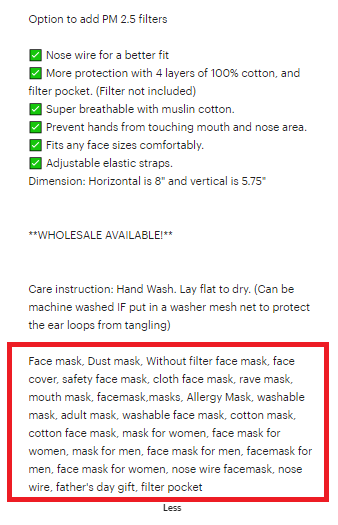
Such keywords can be seamlessly incorporated into the product description or added as tags. You can also include keywords based on other types of search intent as well. This will help increase the chances that your product page will appear in the search results for different queries, increasing the discoverability of your products.
2. Create Unique Product URLs
Another key factor of a good e-commerce product page SEO is a unique product URL. That is, the name of the product should appear in the URL of the product page:
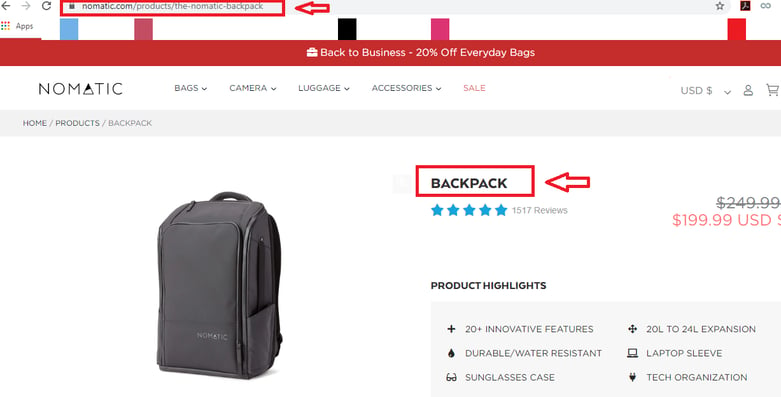
Why is this factor important for an e-commerce product page SEO?
First, when a consumer sees such a URL, they immediately know what to expect when entering the page. But most importantly, if a URL contains relevant keywords, it is easier for Google to crawl and rank such pages higher.
3. Optimize Product Descriptions for Snippets
Featured snippets are selected results in Google search. In product page SEO, optimizing for featured snippets can help an e-commerce business introduce a consumer to the product before they visit the website.
As a result, when a consumer enters a keyword related to your product, they will get a featured snippet of it in the search results:
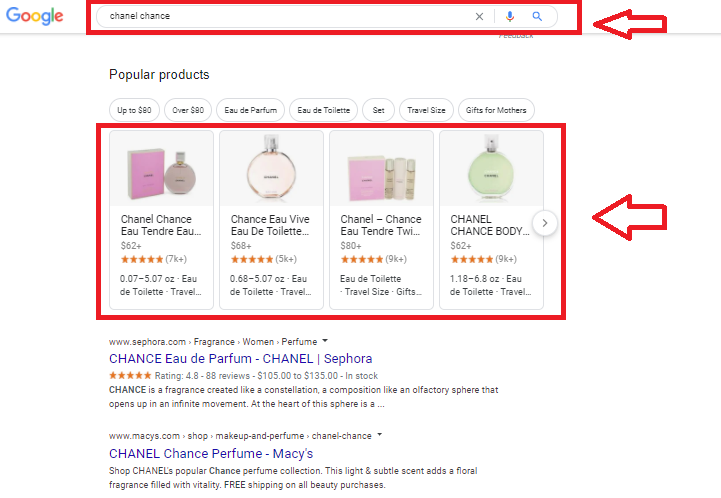
How to optimize your product pages for featured snippets?
- Focus your keywords on search intent. If your product appears at the right time, answering the intent of the searchers, they will be more likely to purchase it.
- Break down your product descriptions. Enumerate every product feature with a bullet list to make the product description easier for Google to crawl. Also, don’t forget about the readability of the product description. To check the text readability fast, you can use tools like TrustMyPaper that offer editing and proofreading services.
- Analyze how people are looking for products. One way you can check it is in the “People also ask” box in Google results. These insights will help you better understand how consumers are looking for product information and expand your list of keywords.
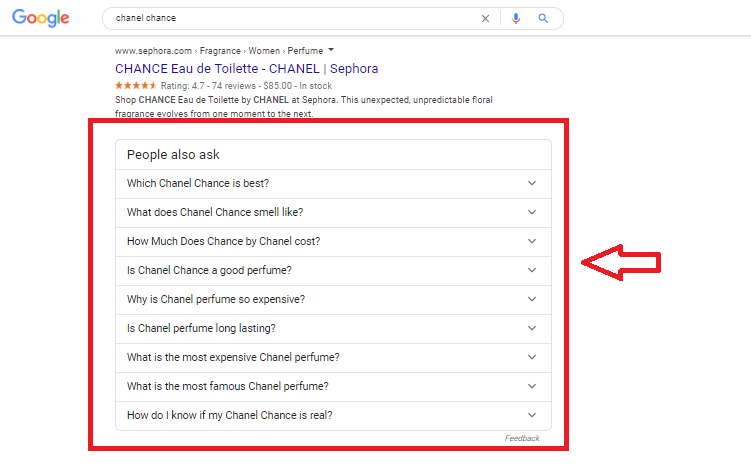
It is also worth mentioning that since a picture of your product will appear in featured snippets, you should also optimize the alt text of this image. The main rule here is to not choose the random text but use keywords that precisely describe your product.
4. Make Your Product Descriptions Unique
Many e-commerce businesses that sell products directly from manufacturers often use the manufacturer’s product descriptions on their websites.
Smart consumers identify such product descriptions right away and will be more likely to leave without purchasing your product. Besides, Google doesn’t like repetitive incoherent text and ranks such content lower.
Instead, add a bit of personalization. Crafting product descriptions is like writing essays – you need to follow a structure and keep readability in mind, but also not forget about creativity. Here’s an example of such a description:
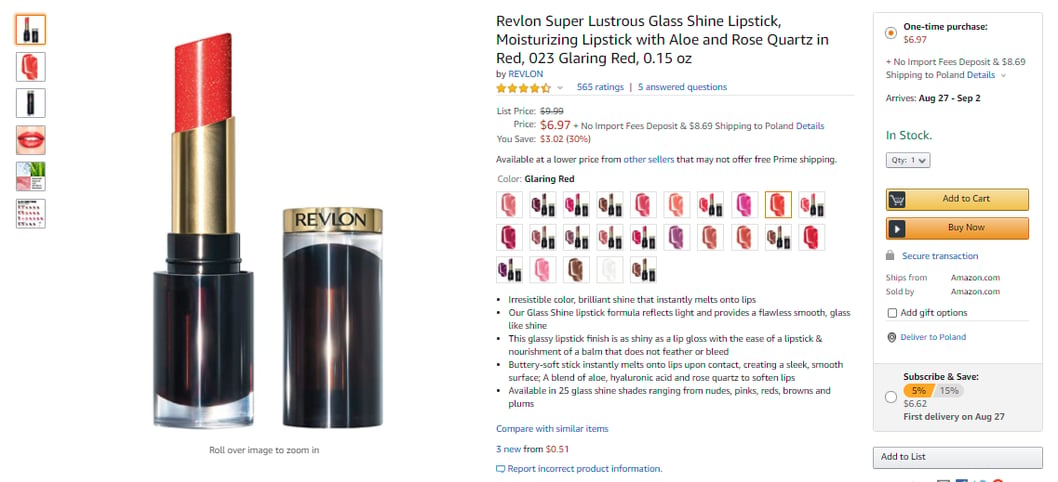
Although the product is very popular and sold by many e-commerce sellers, the description here is quite unique.
Moreover, with words like irresistible, glassy, buttery-soft, this product description paints a picture of what a consumer would expect from the product. And, such unique keywords in the description make the product page better optimized for its target audience.
5. Use Social Proof
Besides the general product descriptions, consumers often look for product reviews, which often push them to their final purchase decision.
Reviews and rankings also play an important role in e-commerce product page SEO because they are the source of credible information, which Google often relies on when ranking websites.
That’s why, if these reviews are available, Google adds them to the featured snippets in the search results:
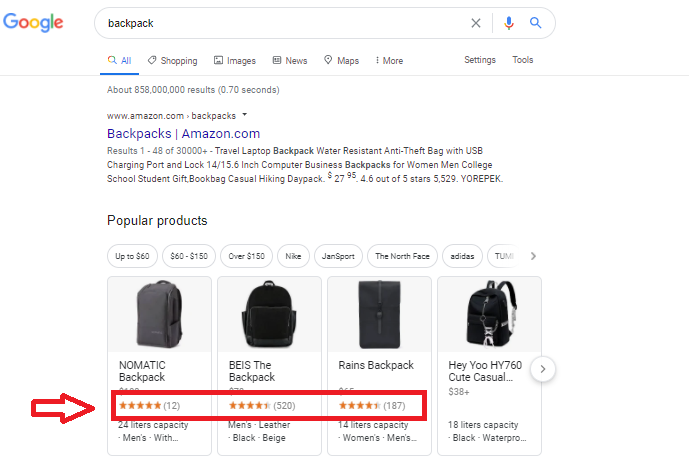
So, since the social proof is important both for consumers and for search engines, make sure that your product pages offer the ability to leave a review and to rank your product.
Over to You
Doing e-commerce product page SEO is a process that needs your attention on many details.
For your product pages to be successful, it’s not enough to stuff them with relevant keywords. Instead, it’s important to optimize these keywords with user intent in mind to make sure that your product appears in the search results at the right time.
On top of that, to make your products more discoverable, give unique URLs to each of them, optimize your product pages for featured snippets, and use social proof.
And, don’t forget that your product descriptions should be unique and speak to the needs of consumers.
Recommended next read: Set up Google Analytics for your eCommerce Website
You may find interesting: 14 Best Practices for Magento SEO or Car Dealership SEO: 7 Practices to Increase Visibility & Sales
